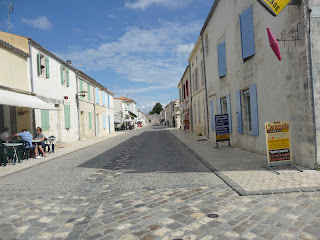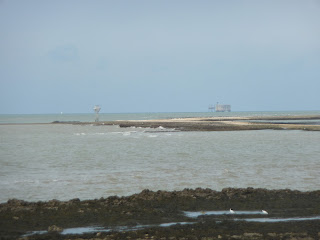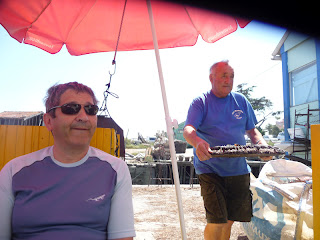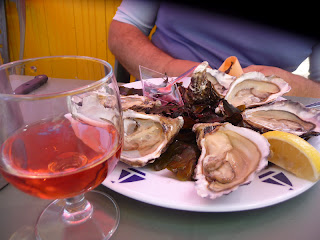And this is where my English for this post ends, sorry to my English and French readers! I was so tired after my last French class and jotted all my thoughts of this past month down in Afrikaans...
Met my M wat eerskomende Vrydag 'n aanvang neem in Parys, en in Frans aangebied word, het ek gedurende Sept klas gedraf by die Alliance Française in Parys (ongelukkig is daar nie een in Reims nie). Na 'n aanvanklike evaluering die dag voor ons vertrek na die Franse weskus vir vakansie, het ek op drie tipe kursusse besluit - 'n skryfkursus wat in 'n groep is, 3h per oggend, 2 oggende 'n week, 'n indivuele klas met 'n prof om spesifiek op besigheidsfrans te fokus (1.5h/week) en 'n individuele kursus (1h/week) met 'n prof om my uitspraak te verbeter. Dit was die aanvanklike plan, hoewel herstelwerk by die Alliance halfpad deur 'n verandering in my skedule, en derhalwe meer druk, veroorsaak het. En op die ou end 2 weke v 2 dae elk in Parys en 2 weke v 3 dae elk (die indiv kursusse het ek die middae vd skryfklas gedoen).
Die skryfkursus was uitstekend in die sin dat die prof verskillende take met ons gedoen het, elke taak bydraend tot meer selfvertroue en die wete dat mens wel by magte is om iets in Frans te kan skryf. Die klas het gewissel tussen 8-12 mense v verskillende lande - Nederland, België, Duitsland, Switzerland, Italië, Spanje, Poland, Thailand, China, Australië, Colombië, Brasilië. En die ouderdomsgroep het gewissel v ongeveer 20 tot 60+. Dit was interessant om aan nuwe mense met verskillende kulture en tale blootgestel te word en ondanks die feit dat meeste v ons waarskynlik beter in Engels met mekaar sou kon kommunikeer, het ons in Frans met mekaar gekommunikeer, almal op 'n redelike goeie vlak v Frans. Die afgetrede Italianer en ek het 'n lang gesprek met mekaar gehad voor hy uiteindelik gesê het hy kan glad nie in Engels kommunikeer nie. Dis wonderlik om te dink mens kan in 'n derde taal met mense kommunikeer wat jy voorheen nie sou kon doen nie.
Die besigheidsfrans was uitdagend en het my laat voel dat ek 'n tweede brein benodig vir al die nuwe woordeskat. Die prof en ek het dadelik gekliek. 'n Spontane, energieke vrou 12 jaar jonger as ek. Haar pa is 'n konsultant aan wynboere in die Loirevallei en laas naweek het ek haar gehelp met die vertaling v 'n Franse kontrak na Engels - en op die ou end 'n lang lys v kortkominge in die Franse kontrak aan haar gestuur, heel trots op myself dat ek al in staat daartoe is om 'n Franse regskontrak te kan analiseer. Sy was so gaaf om vir my orgidieë te koop om dankie te sê (JL is al moedeloos met my wat heeltyd verniet werk vir almal).
Die uitspraakklas was 'n ander storie....Elke les word opgeneem, sodat jy tuis verder kan oefen en seker kan wees vd uitspraak. Ek dink die moeilikste v 'n nuwe taal is as jy reeds oor 'n lang tydperk verkeerde gewoontes aangeleer het en dit skielik met die korrektes moet vervang. Die prof neem jou deur al die klanke v Frans en identifiseer jou swakpunte, waarna jy daarop moet fokus (2-4 klanke per les, baie intensief!) Sy leer jou om jou mond vir sekere klanke soos Donald Duck te vorm, ander soos Marilyn Monroe, ander soos 'n hart, ander soos 'n vierkant (ja, dis die moeilikste een!). Jy is later so deurmekaar, jy weet nie of jy Donald Duck of Marilyn Monroe moet wees nie.
Toevallig het ek Ernest Hemingway se 'A moveable feast' begin lees ongeveer dieselfde tyd wat ek met die skool begin het. Die boek handel oor sy memoires v sy verblyf in Parys gedurende die vroeë twintigs en die area wat hy hoofsaaklik beskryf speel af in die area waar die skool geleë is (baie goeie boek, my eerste v hom, maar beslis 'n boek om aan te beveel, ek dink hy was briljant!). Ondanks my voornemens om vd nou straatjies te gaan verken, die oorspronklike ligging v Shakespreare & Company te gaan opsoek en 'n koffie in sy gewildste kafee naby Montparnasse te gaan drink, het die 3 verskillende kursusse en uitstekend toegeruste mediateek my voltyds besig gehou. Die area was in sy era die armste buurt in Parys, hoofsaaklik omrede heelwat mense gedurende daardie tydperk vanaf Bretagne (die noordwestelike gedeelte v Frankryk, die neus wat uitsteek) na Parys verhuis het om die armoede v Bretagne te probeer ontsnap. Die treinstasie waar hul in Parys arriveer het, was Montparnasse en dus het hulle hul in die area gevestig. Volgens 'n onlangse artikel in 'n Franse tydskrif is hierdie area rondom Jardin de Luxembourg nou die area waar jy die hoogste prys per m2 in Parys betaal!
Nie meer gewoond aan klasdraf nie en suf in die kop het ek na 3h se klas in die oggend verkies om eerder die 'vars' buitelug op te soek as om in die kantien te gaan sit. Helaas, die onmiddelike omgewing rondom die skool het nie kafeetjies nie en mens moet 'n paar honderd meter stap.
Rue Raspail, die straat waarin die skool geleë is, is 'n breë straat met 'n eiland in die middel, noord v die kruising met Rue de Rennes is hul weeklikse mark en dis ook waar jy die eerste restaurant vind. Verder noord vind jy modewinkels, interieurwinkels. Die breë straat met sy bome en elegante, dekoratiewe geboue is 'n plesier om in te wandel. Vd kafees in die area verplaas jou 'n hele paar jaar terug in die geskiedenis met hul dekoratiewe interieur vanuit 'n vorige era.
Jy dink jy ken die geboue, dan loop jy een dag aan die ander kant vd straat en sien dekorasies op die geboue aan die oorkant wat jy misgekyk het toe jy reg onder hul verbygeloop het. Môre wag jy by die rooilig by die voetoorgang en jou oog dwaal opwaarts teen die geboue tot jy die reuse figure vir die eerste maal aan die bokant vd geboue raaksien, die geskulpte balkonne met hul dekoratiewe gietysterrelings. Dis die vreugde v Parys beleef as 'n 'inwoner' eerder as 'n toeris.
Rue de Rennes, 'n besige breë straat wat Rue Raspail kruis en na Montparnasse toring lei, met heelwat skoen- en modewinkels is 'n miernes tydens middagetes. Die mense tou ongeveer 20 meter buite op die sypaadjie v 'n bakker. Hoe nader jy aan Saint Sulpice beweeg, hoe meer kafees en restaurante. My gunsteling is Café Metro, reg langs die metro vir Saint Sulpice en ongeveer 100 m vanaf die groot plein met sy reuse fontein voor die kerk. Dis 'n kafee wat deur 'n derde of vierde generasie bestuur word en jou ook verplaas na 'n vorige era, ondanks die feit dat die platskerm tv bo die deur in stilte die nuus verkondig.
Saint Sulpice het kafee's met hul eie bekoring. Die tafeltjies is in rye gepak en die styfgepakte stoele in rye agtermekaar kyk almal in die rigting vd sypaadjie. Jy klou jou handsak op jou skoot en weet nie waar om met die res v jou inkopies te gaan nie, mense links, regs, voor, agter, kelners wat hul paaie oopveg om drankies af te lewer en seker te maak dat hul die geld ontvang. Ondanks die ongerief kan mens die verbygangers bestudeer, die reuse fontein bewonder, die kerk wat 'n paar jaar gelede gerestoureer is.
Ek het soggens die metro geneem tot by Saint Placide, 'n besige kruising waar Rue de Rennes 5 ander strate kruis, met kafee's op die straathoeke. Die een 'n créperie wat jou 'n uitsig bied op Montparnasse toring. Die ander met klein ronde tafeltjies, waar kelners dek vir 2, maar 1 plekmatjie reeds die tafel vul, met hul tipiese rottangstoele. Ondanks die feit dat dit op die sypaadjie ingedruk is en voetgangers reg langs jou verbyskuur en busse en karre langs hul verbydreun, soek mens hierdie buitetafeltjies op om die flou sonnetjie te kan geniet (wat halfpad deur die ete verdwyn en al wat bly is 'n ysige skraal windjie...).
Daar is heelwat skole en universiteite in die omgewing - die Sorbonne, Science Po en andere, wat studente lok v oral oor die wêreld en tesame met die toeriste hoor mens soms meer Engels of ander tale in die strate as Frans.
Die roete vanaf die metro na die skool het my verby 'n blommewinkel gelei waar die vars geur v blomme die oggend gevul het en mens vir 'n oomblik laat vergeet vd stadsgedruis. Die naam vd blommewinkel is vernoem na 'n bekende park, Monceau, wat jy aan die ander kant vd Seine vind.
Ek moes elke oggend die lyn vanaf Gare de l'Est neem, nr 4 - seker die besigste en goorste lyn vd metro. Dis regtig baie besig. Desondanks het ek spoedig geweet waar die mense verminder en waar hul vermeerder. En middae het ek lyn 12 vanaf metro Rennes geneem tot by Madeleine en vandaar lyn 8 na Opera. Die metro se mosaïekteëls vertel jou of jy in Montparnasse of Montmarte se rigting gaan, in outydse skrif. Binne 'n oogwink leer mens die metro ken, weet jy waar op die platform om te staan om maklik plek te kry, waar om te staan om nie so baie hoef te loop by jou konneksie nie. Lyn 12 is onder Rue Raspail en mens voel die metro se gedreun selfs in jou klas op die 4e vloer vd Alliance.
By Opera is daar altyd 'n gedruis. Sambreelverkopers by die uitgange om voordeel te trek uit die onverwagse reënbui wat uitgesak het (gelukkig is my sambreel deesdae permanent by my), toeriste met tasse, besigheidsmense wat jaag om betyds te wees vir 'n vergadering, bedelaars. Desondanks bewonder ek steeds die pragtige gebou as ek daar verbystap op pad na JL se kantoor waar ek hom gewoonlik middae kry. Die bedelaar wat permanent op die straathoek sit of lê, sonskyn of reën, irriteer my grensloos. Ek lag vir die lang tou wat voor die Apple kantore staan in afwagting om die nuwe iphone te koop - om by JL en sy kollegas te hoor dat die tou nog langer was in die oggend en mense blykbaar reeds vanaf middernag begin tou het (en dit was 'n koue nag). By JL se kantoor stoot mens die swaar reuse houtdeur oop en betree 'n geplaveide binnearea vanwaar jy verskillende geboue kan binnegaan. Hul gebou het nog 'n groot swaar hout- en glasdeur waarna jy met 'n halfmaanwenteltrap, bedek met 'n swaar rooi tapyt, opgaan na die eerste vloer.
Die mense raak meer in Parys, die atmosfeer het verander oor jare, maar die geboue bly pragtig en die breë strate maak v Parys steeds 'n spesiale stad.
Sunday, September 30, 2012
Thursday, September 20, 2012
Our last few days of holiday
We've managed to get a table at one of our favourite restaurants in St Trojan (thanks to us making a booking the previous day...)
And the stage for the evening concert was set up right in front of us
It was on a movable flot which was finally turned on the water that people eating at restaurants on both sides of the port can enjoy the concert
Above: one of the restaurants on the other side
Below: the stage on the water
We've decided on our last day, as the weather was not so good, to explore the north western part of the island. It is more rocky than than the other beaches, but we found an interesting concept - take a careful look at the photo above: you'll notice the bow shape of the rocks furthest from the beach. It is part of Les écluses à poissons (sluices to fish) which you'll find not only here but also at île de Ré and Noirmoutier. The earliest writing you'll find about it dates back to the 14th-c although it is believed to be much older, probably dating back to the Gallo-Roman era. The walls are constructed from rocks found in the area and have openings with, previously wood, and now metal gates in it. Before the islands were linked by bridges to the mainland, life was very tough on the islands and this concept made it easier to fish, as the water (with the fish) entered through the openings and the people could take out more fish.
When leaving île d'Oléron to return for another 2 days at Fouras before heading home, JL decided to take me on another road that I do not know. We've passed through Brouage with its ancient fort, which we have visited the first time I've been to Fouras. Today surrounded by land, it was an important port at one stage and a Catholic stronghold, as Richelieu wanted it to compete with the Huguenot La Rochelle. It is a military town of origin with very square streets, not the narrow winding roads you'll find in villages/towns that originated in the Roman era. Samuel de Champlain, founder of Quebec in Canada, was born in Brouage and the memorial below, in front of the church, is dedicated to him.
Very square streets...
And the outer wall surrounding the village
We continued to île Madame, the smallest of the four islands in the region (400x800m). You can access the island by car when it is low tide and we arrived just at the good time. Even though I was a bit worried as we drove on the wet rocky road...
The island is very involved with aquaculture and oyster farming, as well as salt harvesting.
One has a beautiful view of Fouras from île Madame, with fort Vauban a prominent feature
île Madame has a small beach
One has to take care, as you can be cut off on the furthest part of the island and covered by water once it is high tide (the region is subject to huge differences during high and low tide). A rescue platform was built (below, on the left, the right if fort Broyard) in case you misjudge the tide and are caught by the water
The warning sign and explaining that you should use the rescue platform in case being caught by the tide...
Tuesday, September 4, 2012
Cycling on île d'Oléron
Well, we've pretty much cycled every day, to the beaches, restaurants, the salt museum. But after the worst of the heat wave was over, we've decided to explore the island a bit further, into the heart of the salty marshes on the east coast of the island.
In France you always have farms close-by. It contributes to the rural feel of the country.
The salty marshes occupied by the oyster farmers
Above: the tied is coming in, so some boats are going out onto the sea
Below: we've cycled to a point called Bellevue (beautiful view) and after walking through this wild area covered by salicornia and other plants, along a small sandy path, we got to a long sandy beach with, yes, you've guessed it, a beautiful view
JL was good enough to gather from the map that we're not too far from an oyster seller/restaurant, Chez Mamadou, which was fully booked when we've stopped there a few days earlier with the car. They were packed, but we've managed to got a table and waited patiently for them to come and clean the table, and then for the food - but it was worth the waiting. We've enjoyed the view on the colourful cabins and the salty mashes flowing into the sea. As one could have églade there, I've decided, looking at the omie below doing it, to give it a try - he seemed like an old hand. We had a laugh at a couple who arrived and pulled up their noses for this restaurant which looks a bit like your friends' backyard where you're going for a braai. Never pull up your nose for such a place in France - they are the hidden gems!!
The broom was standing next to us - until the omie needed it and I've realised it is to sweep all the pine needles falling from the bag to the barbeque
And he is the waiter as well (for the églade, the other dishes are served from the kitchen by others)
Below: JL decided to try a bigger oyster than usually (a nr 2 vs a nr 3)
The églade in preparation - removed from the fire, but the mussels that didn't open are painstakingly removed
Below: mmm, it looks good! (and it was!!)
The entrance to the restaurant is the area selling the oysters and mussels
And our (rented) bikes!
Sunday, September 2, 2012
Sunset concert on the beach
Another fête: we've decided to take the tourist train for a sunset concert on the beach close to St Trojan. On arrival, we got a lecture about the dunes, etc (not that people were paying much attention, being more interested in the sunset). The concerning fact was that the train's terminal was 800 m further 30 years ago, but that land had since been lost to the ocean.
The artists busy setting up on the open train wagon
And the audience, around the take-away restaurant. After the heat wave 20°C was very cold, and even worse with the cold wind blowing. We ended up wrapping ourselves in our picnic blanket (we've planned to picnic during the concert, but on arrival at the ticket office at 6.30, the time the tourist office gave us, we've learned that the train only departs at 8.15 - so we left to plage Gatseau to picnic there before departing)
I felt sorry for the artists. The wind was getting colder and stronger (the artists had to ask the parents to keep their little monsters under control as they were kicking up sand that blew into the mouths of the artists) and most people left to sit on the train while the artists were still singing their last song. But then, there are many artists during the holiday, some better than others. Le Château's being the worst we've heard, St Trojan's the best and the others in between. Even though these artists weren't too bad, they were not as good as the jazz artists we've been listening to the previous evening at Le-Grand-Village.
The oyster industry of the Charente
In a nutshell: France is the 4th biggest oyster producing country (China is first with 70% of the world production). And this region produces 50% of France's production, with 60% of the production being consumed locally in the region. That equals finding oysters on all the menus, being able to purchase it from the colourful cabins dotting the island, numerous fish markets selling oysters, whether just like that or as a take-away platter with the numerous other types of seafood they are blessed with in this region. We've stopped at St Trojan again the one day, our visit resulting in JL buying some oysters as a snack.
The colourful cabins lining the port of St Trojan
Below: the stage for the evening music concert already being prepared, next to some oyster boats
JL buying his oysters from a stand along the road - 6 oysters and a glass of wine for only €5 (ca. R50). I though they were original with their tray...
You can see the oysters in the bags on top of the boat
Not only the oyster cabins are colourful...
We've decided to educate ourselves and left to mainland France to visit the Marennes. About 6 years ago a very successful project combining aquaculture and tourism was opened. You can visit a museum, one of many restaurants, oyster growers selling oysters, or go on a boat trip (like we did) to have a look at the reserve.
The oysters growing in the park. It was low tide, during high tide they are covered by the water when they eat plankton and filter the water (although the water is in a good condition in this region, there are numerous blue flag beaches).
Oyster farming already commenced in the 1800's with the foresight of Napoleon. He ordered that the oysters can only be harvested a certain time of year, to protect them during the time of reproduction. This lead to the start of the oyster farms. Despite this protection, the region was hit by a disease in the 1920's, resulting in Portuguese oysters having to be introduced into the region to replace the region's oysters. Then another disease by 1970 led to the successful introduction of Japanese oysters.Today, you have more than 5000 ha of oyster farms in the area (and employing even more people than hectares). The area around the Marennes and île d'Oléron is a park where people are not allowed to take out oysters, except if you are a registered oyster grower.
Oysters change sex during their 3 year period before ready to be harvested - in order to reproduce.
Subscribe to:
Comments (Atom)



















































